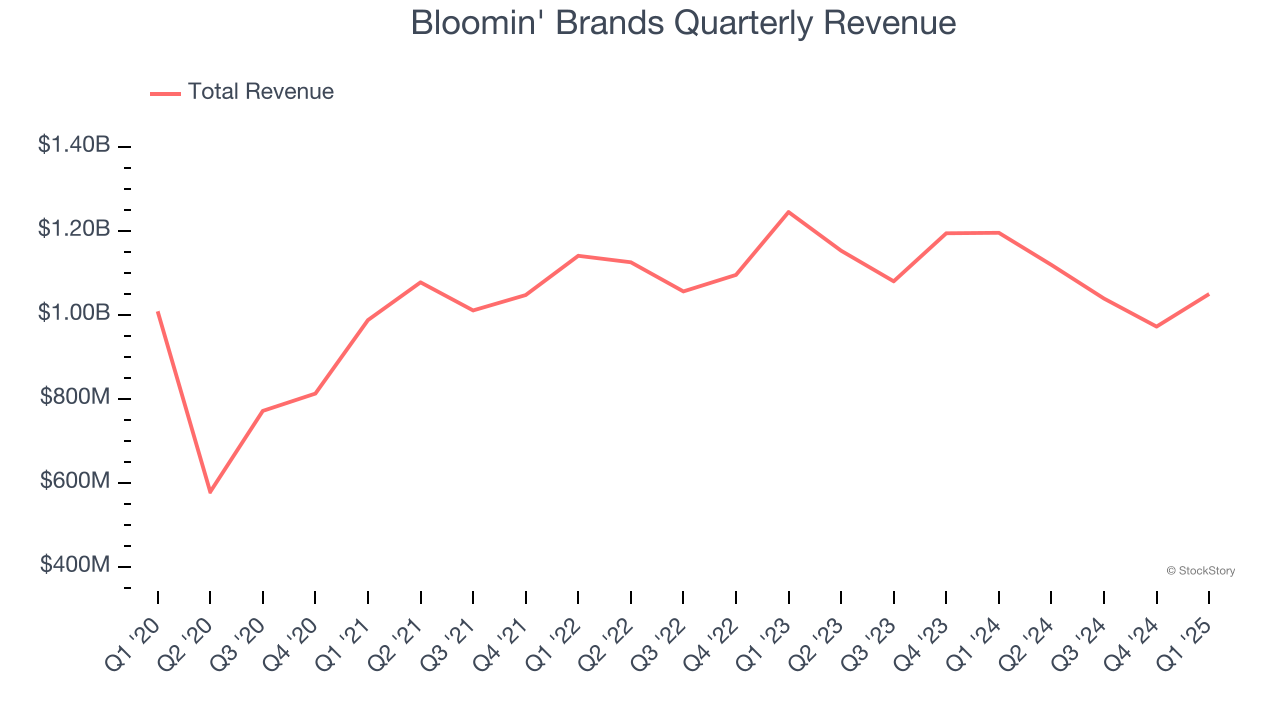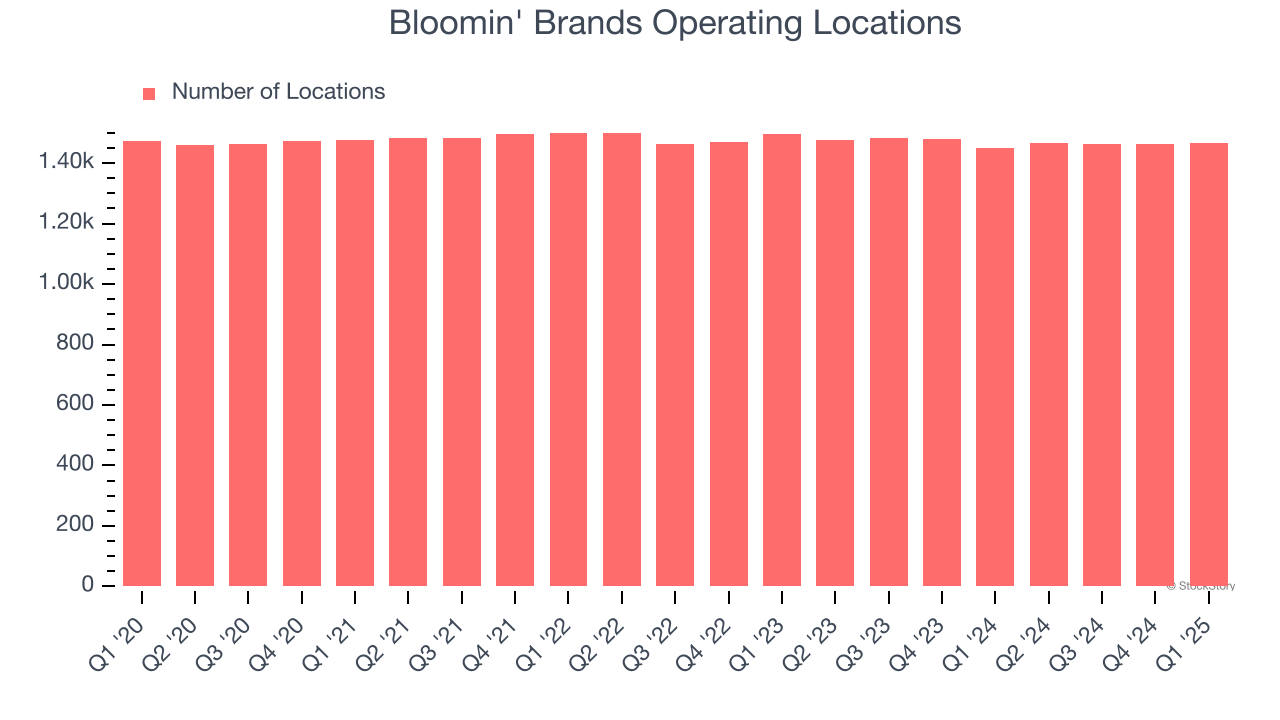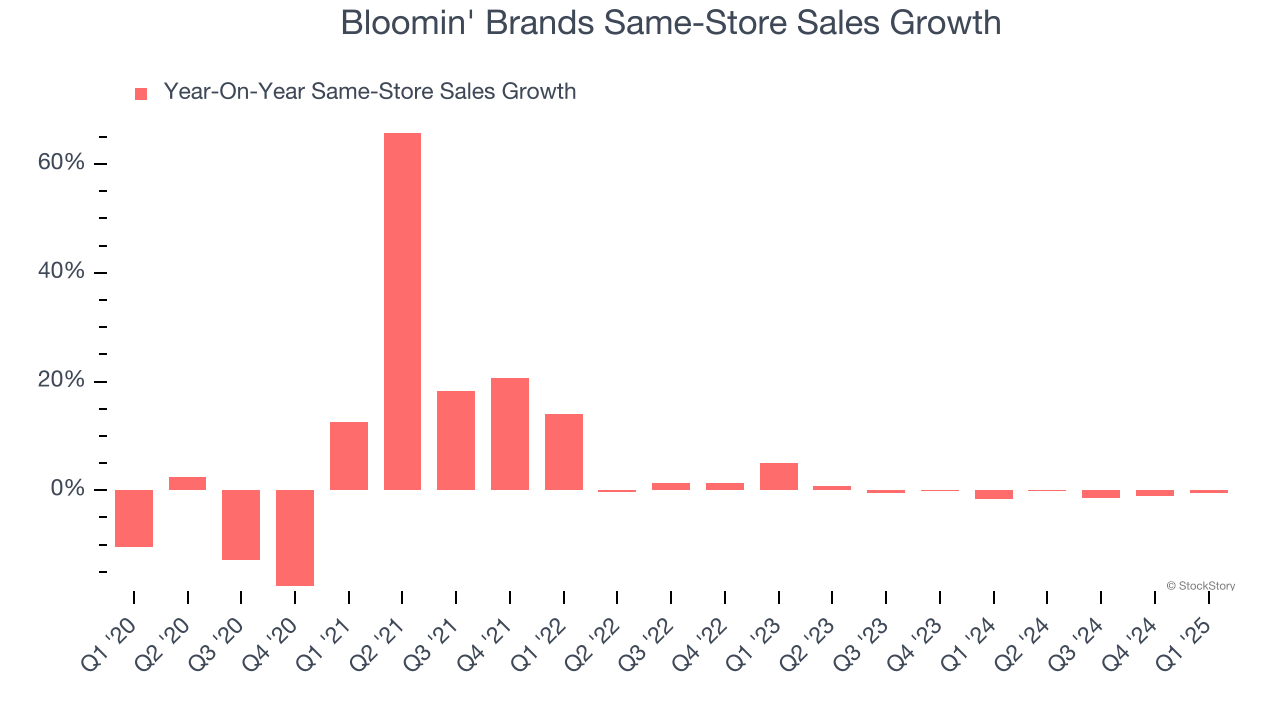
Restaurant company Bloomin’ Brands (NASDAQ: BLMN) beat Wall Street’s revenue expectations in Q1 CY2025, but sales fell by 12.2% year on year to $1.05 billion. Its non-GAAP profit of $0.59 per share was 3.4% above analysts’ consensus estimates.
Is now the time to buy Bloomin' Brands? Find out by accessing our full research report, it’s free.
Bloomin' Brands (BLMN) Q1 CY2025 Highlights:
- Revenue: $1.05 billion vs analyst estimates of $1.04 billion (12.2% year-on-year decline, 1.2% beat)
- Adjusted EPS: $0.59 vs analyst estimates of $0.57 (3.4% beat)
- Adjusted EBITDA: $101.2 million vs analyst estimates of $111 million (9.6% margin, 8.8% miss)
- Adjusted EPS guidance for Q2 CY2025 is $0.25 at the midpoint, below analyst estimates of $0.37
- Operating Margin: 5.5%, in line with the same quarter last year
- Locations: 1,466 at quarter end, up from 1,451 in the same quarter last year
- Same-Store Sales were flat year on year (-1.6% in the same quarter last year)
- Market Capitalization: $673.5 million
Company Overview
Owner of the iconic Australian-themed Outback Steakhouse, Bloomin’ Brands (NASDAQ: BLMN) is a leading American restaurant company that owns and operates a portfolio of popular restaurant brands.
Sales Growth
Examining a company’s long-term performance can provide clues about its quality. Any business can put up a good quarter or two, but many enduring ones grow for years.
With $4.18 billion in revenue over the past 12 months, Bloomin' Brands is one of the larger restaurant chains in the industry and benefits from a well-known brand that influences consumer purchasing decisions. However, its scale is a double-edged sword because there are only a finite of number places to build restaurants, making it harder to find incremental growth. To expand meaningfully, Bloomin' Brands likely needs to tweak its prices, start new chains, or enter new markets.
As you can see below, Bloomin' Brands struggled to increase demand as its $4.18 billion of sales for the trailing 12 months was close to its revenue six years ago (we compare to 2019 to normalize for COVID-19 impacts). This was mainly because it didn’t open many new restaurants.

This quarter, Bloomin' Brands’s revenue fell by 12.2% year on year to $1.05 billion but beat Wall Street’s estimates by 1.2%.
Looking ahead, sell-side analysts expect revenue to decline by 6.1% over the next 12 months, a deceleration versus the last six years. This projection doesn't excite us and suggests its menu offerings will face some demand challenges.
Software is eating the world and there is virtually no industry left that has been untouched by it. That drives increasing demand for tools helping software developers do their jobs, whether it be monitoring critical cloud infrastructure, integrating audio and video functionality, or ensuring smooth content streaming. Click here to access a free report on our 3 favorite stocks to play this generational megatrend.
Restaurant Performance
Number of Restaurants
A restaurant chain’s total number of dining locations often determines how much revenue it can generate.
Bloomin' Brands listed 1,466 locations in the latest quarter and has kept its restaurant count flat over the last two years while other restaurant businesses have opted for growth.
When a chain doesn’t open many new restaurants, it usually means there’s stable demand for its meals and it’s focused on improving operational efficiency to increase profitability.

Same-Store Sales
A company's restaurant base only paints one part of the picture. When demand is high, it makes sense to open more. But when demand is low, it’s prudent to close some locations and use the money in other ways. Same-store sales is an industry measure of whether revenue is growing at those existing restaurants and is driven by customer visits (often called traffic) and the average spending per customer (ticket).
Bloomin' Brands’s demand within its existing dining locations has barely increased over the last two years as its same-store sales were flat. This performance isn’t ideal, and we’d be skeptical if Bloomin' Brands starts opening new restaurants to artificially boost revenue growth.

In the latest quarter, Bloomin' Brands’s year on year same-store sales were flat. This performance was more or less in line with its historical levels.
Key Takeaways from Bloomin' Brands’s Q1 Results
It was good to see Bloomin' Brands narrowly top analysts’ revenue expectations this quarter. On the other hand, its EPS guidance for next quarter fell short of Wall Street’s estimates. Overall, this quarter was mixed. The stock remained flat at $7.89 immediately following the results.
The latest quarter from Bloomin' Brands’s wasn’t that good. One earnings report doesn’t define a company’s quality, though, so let’s explore whether the stock is a buy at the current price. We think that the latest quarter is only one piece of the longer-term business quality puzzle. Quality, when combined with valuation, can help determine if the stock is a buy. We cover that in our actionable full research report which you can read here, it’s free.

